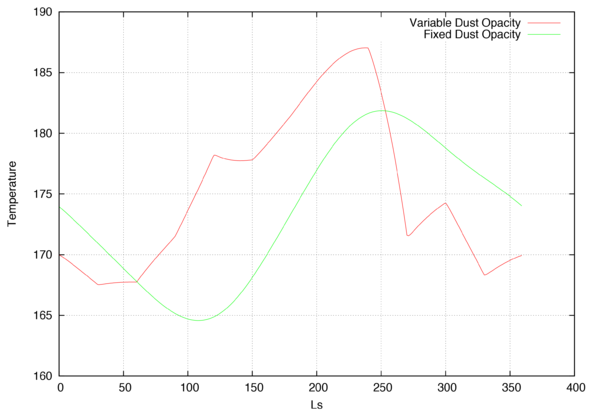Category:KRC Tutorial
Starting the KRC function
To start the KRC function in davinci, simply run the krc() function:
% davinci dv> krc()
When started in this manner, the krc function will provide some context and definitions for some of the most common inputs
Simple Runs for Mars
Now let's run KRC for a simple case on Mars to determine the surface temperature in Gale Crater (latitude = -4.5; longitude = 137.4)
dv> out=krc(lat=-4.5,lon=137.5)
Read TEXT file: 61 lines
Found Default File: $DV_SCRIPT_FILES/krc_support/porb_defaults/Mars_Mars.porb.hdf
./Applications/davinci.app/Contents/Resources/library/script_files/krc_support/ti_map2ppd_v4.vicar: VICAR bsq image: 720x360x1, 32 bits
./Applications/davinci.app/Contents/Resources/library/script_files/krc_support/albedo_2ppd.vicar: VICAR bsq image: 720x360x1, 32 bits
./Applications/davinci.app/Contents/Resources/library/script_files/krc_support/mola_2ppd.vicar: VICAR bsq image: 720x360x1, 32 bits
Running KRC model with:
Output:
Every ~1.000 Ls (1.9083 JD) for 360 seasons starting at 0.10 Ls
For 96 times per day, every 15 local minutes
Running model WITH NO temperature prediction
because DELJUL < 3.0779
For a Surface With:
29 Layers with uniform material properties and 384 daily model time steps
and T-dependant material properties
and an insulating bottom edge condition
With Observation Parameters:
LATITUDE: -4.50 LONGITUDE: 137.50
ELEVATION: -3.606km^ SLOPE/AZIMUTH: 0.00/0.00deg
ALBEDO: 0.228^ OPACITY: 0.300
HOUR: All LS: All
Upper Material:
INERTIA: 230.00
CONDUCTIVITY: 0.0502*
DENSITY: 1770.00*
SPECIFIC HEAT: 595.55
POROSITY: 0.40
* = derived value unless overwritten by user
^ = from TES 2ppd map unless overwritten by user
& = ajusted for max authorized value
struct, 14 elements
tsurf: 96x1x360 array of double, bsq format [276,480 bytes]
tbol: 96x1x360 array of double, bsq format [276,480 bytes]
tatm: 96x1x360 array of double, bsq format [276,480 bytes]
down_ir: 96x1x360 array of double, bsq format [276,480 bytes]
down_vis: 96x1x360 array of double, bsq format [276,480 bytes]
time: 96x1x1 array of float, bsq format [384 bytes]
ls: 1x1x360 array of double, bsq format [2,880 bytes]
lat: -4.50000
elev: -3.60558
layer: struct, 8 elements
thickness: 28x2x1 array of double, bsq format [448 bytes]
center: 28x2x1 array of double, bsq format [448 bytes]
top: 28x2x1 array of double, bsq format [448 bytes]
center_mass: 28x1x1 array of double, bsq format [224 bytes]
mass_burden: 28x1x1 array of double, bsq format [224 bytes]
thermal_scales: 28x1x1 array of double, bsq format [224 bytes]
tmax: 28x1x360 array of double, bsq format [80,640 bytes]
tmin: 28x1x360 array of double, bsq format [80,640 bytes]
anc: struct, 11 elements
krccom: struct, 5 elements...
JDate: 1x1x360 array of double, bsq format [2,880 bytes]
ref_pressure: 1x1x360 array of double, bsq format [2,880 bytes]
taud: 1x1x360 array of double, bsq format [2,880 bytes]
total_frost: 1x1x360 array of double, bsq format [2,880 bytes]
avg_heat_flow: 1x1x360 array of double, bsq format [2,880 bytes]
frost_alb: 1x1x360 array of double, bsq format [2,880 bytes]
frost: 1x1x360 array of double, bsq format [2,880 bytes]
tatm_predict: 1x1x360 array of double, bsq format [2,880 bytes]
delta_t_rms: 1x1x360 array of double, bsq format [2,880 bytes]
converge_days: 1x1x360 array of double, bsq format [2,880 bytes]
version: "v3.2.1"
alb: 0.228235
body: "Mars"
The output is a structure containing various model parameters, as well a calculated quantities.
Surface temperatures are stored in .tsurf, local times in .time, and Ls in .ls Local times are stored in the x axis, depth in the y axis (not used yet), and season in the z axis.
So let's plot a diurnal temperature curve at Ls = 0.1 (first ls index):
dv> plot(out.tsurf[,1,1],xaxis=out.time) dv>
Let's plot a seasonal temperature curve at 0:25 (first time index):
dv> plot(out.tsurf[1,1,],xaxis=out.ls) dv>
When provided with the coordinates of a specific location on Mars, the krc() function reads some contextual information from external maps:
- the elevation: ELEVATION: -3.606km
- the albedo: ALBEDO : 0.228
Of course, these parameters can be set by the user:
dv> out=krc(lat=-4.5,lon=137.5,ALBEDO=0.22,ELEV=-4.5) dv>
Frequently, you will want to work with a specific Ls
dv> out=krc(lat=-4.5,lon=137.5,ls=122.45) dv>
More generally, any parameter listed in an input file can be used as an input; run krc() to see the list of variable names.
dv> out_1=krc(lat=-4.5,lon=137.5,ALBEDO=0.22,ELEV=-4.5,INERTIA=120.,SLOPE=12.,SLOAZI=45.,N24=36,SPEC_HEAT=600.,PTOTAL=610.) dv> out_2=krc(lat=-4.5,DUSTA=0.91,ARC2=0.6,TAURAT=0.201)
Make sure to read the helplist to familiarize yourself with the definition and range of inputs.
More Advanced Functionalities
In this section, a few more advanced functionality are presented.
- Time-Dependent Albedo
KRC can work with Ls dependent surface albedo values. The input format is a 2 column array, with Ls and albedo values along the y axis.
dv> ALBEDO_ARRAY dv> 2x12x1 array of float, bsq format [96 bytes] 0.00000 0.230000 30.0000 0.250000 60.0000 0.270000 90.0000 0.250000 120.000 0.230000 150.000 0.220000 180.000 0.220000 210.000 0.250000 240.000 0.230000 270.000 0.250000 300.000 0.270000 330.000 0.250000 dv> out_1=krc(lat=0.,INERTIA=45.,ALBEDO=ALBEDO_ARRAY,hour=4.5) dv> out_2=krc(lat=0.,INERTIA=45.,ALBEDO=0.24,hour=4.5) dv> plot(out_1.tsurf,"Variable Albedo",out_2.tsurf,"Fixed Albedo",Xaxis=out_1.ls) dv>
- Time-Dependent Opacity
dv> TAU_ARRAY
2x12x1 array of float, bsq format [96 bytes] 0.00000 0.310000 30.0000 0.320000 60.0000 0.400000 90.0000 0.600000 120.000 0.910000 150.000 0.720000 180.000 0.650000 210.000 0.600000 240.000 0.550000 270.000 0.200000 300.000 0.300000 330.000 0.230000 dv> out_1=krc(lat=0.,INERTIA=45.,TAUD=TAU_ARRAY,hour=4.5) dv> out_2=krc(lat=0.,INERTIA=45.,TAUD=0.4,hour=4.5) dv> plot(out_1.tsurf,"Variable Dust Opacity",out_2.tsurf,"Fixed Dust Opacity",Xaxis=out_1.ls) dv>
- Temperature-dependent Specific heat
- Temperature-dependent Conductivity
- Two layer Regolith
This category currently contains no pages or media.



